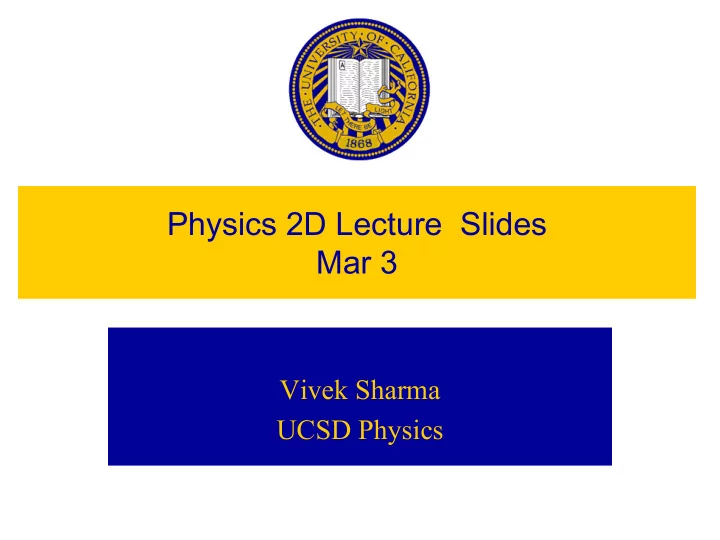

Physics 2D Lecture Slides Mar 3 Vivek Sharma UCSD Physics
• Read Scientific American Special Issue on Modern Phys: – “The Edge of Physics” : online @ www.sciam.com • Hardcopy Available at Bookstar (Costa Verde in UTC area) • Introducing Prof. Kim Griest : – “Why study Physics ?”…how to make money & learn Cool stuff – Dark matter & Dark Energy in the Universe
Measurement Expectation: Statistics Lesson • Ensemble & probable outcome of a single measurement or the average outcome of a large # of measurements ∞ n ∑ ∫ xP x dx ( ) n x + + + i i n x n x n x .... n x < >= = = = −∞ x 1 1 2 2 3 3 i i i 1 ∞ + + + n n n ... n N ∫ 1 2 3 i P x dx ( ) − ∞ For a general Fn f(x) : Sharpness of A Distr ∞ n ∑ ∫ ψ ψ * ( ) ( ) ( ) x f x x dx n f x ( ) Scatter around average i i < >= = = −∞ f x ( ) i 1 ∑ ∞ − 2 N (x x ) ∫ P x dx ( ) σ i = N −∞ σ − 2 2 = ( x ) ( ) x σ → = small Sharp distr. ∆ σ Uncertainty X =
Particle in the Box, n=1, <x> & ∆ x ? π 2 ψ (x)= sin x L L ∞ π π 2 sin 2 ∫ <x>= x x sin x dx L L L L ∞ - L π π 2 ∫ 2 θ = x sin x dx , change variable = x L L L 0 π 2 1 ∫ ⇒ θ θ θ = − θ 2 2 <x>= sin , use sin (1 cos2 ) π 2 L 2 0 π π 2L ∫ ∫ ∫ ∫ ⇒ θ θ θ θ θ <x>= d - cos2 d use ud v=uv- vdu π 2 2 0 0 = π 2 L L ⇒ ψ 2 <x>= (same result as from graphing ( )) x π 2 2 2 L π 2 2 L L ∫ = − 2 2 2 Similarly <x >= x s in ( x dx ) π 2 L 3 2 0 2 2 2 L L L ∆ 2 > − < > = 2 − − = and X= <x x 0.18 L π 2 3 2 4 ∆ X= 20% of L, Particle not sharply confi ned in Box
Expectation Values & Operators: More Formally • Observable: Any particle property that can be measured – X,P, KE, E or some combination of them,e,g: x 2 – How to calculate the probable value of these quantities for a QM state ? • Operator: Associates an operator with each observable – Using these Operators, one calculates the average value of that Observable – The Operator acts on the Wavefunction (Operand) & extracts info about the Observable in a straightforward way � gets Expectation value for that observable +∞ ˆ ∫ < >= Ψ Ψ * * Q ( , ) [ ] x t Q ( , ) x t d x −∞ ˆ Q is the observable, [ ] is the operator Q < > & Q is the Expectation va lue � d Exam p les : [X] = x , [P] = i dx 2 2 ∂ 2 ∂ [P] - � = [K] = 2 2 [E] = i � ∂ ∂ m 2m x t
Operators � Information Extractors � d ˆ [p] or p = Momentum Operator i dx gives the value of average mometum in the following way: ∞ ∞ + + ψ � d ∫ ∫ ψ ψ ψ * * <p> = (x) [ ] ( ) p x dx = (x) dx i dx ∞ ∞ - - Similerly : Plug & play form 2 2 � d ˆ [K] or K = - gi ves the value of average K E 2 2m dx ∞ ∞ + + ψ 2 2 � d ( ) x ∫ ∫ ψ ψ = ψ − * * <K> = (x)[ K ] ( ) x dx (x) dx 2 2m dx ∞ ∞ - - Similerly ∞ + ∫ ψ ψ * <U> = (x )[ U x ( )] ( ) x dx : plug in the U(x) fn for that case ∞ - ∞ ∞ + + ψ 2 2 � d ( ) x ∫ ∫ ψ + ψ = ψ − + * * an d <E> = (x)[ K U x ( )] ( ) x dx (x) U x ( ) dx 2 2m dx ∞ ∞ - - Hamiltonian Operator [H] = [K] +[U] ∂ The Energy Operator [E] = i � informs you of the averag e energy ∂ t
Recommend
More recommend